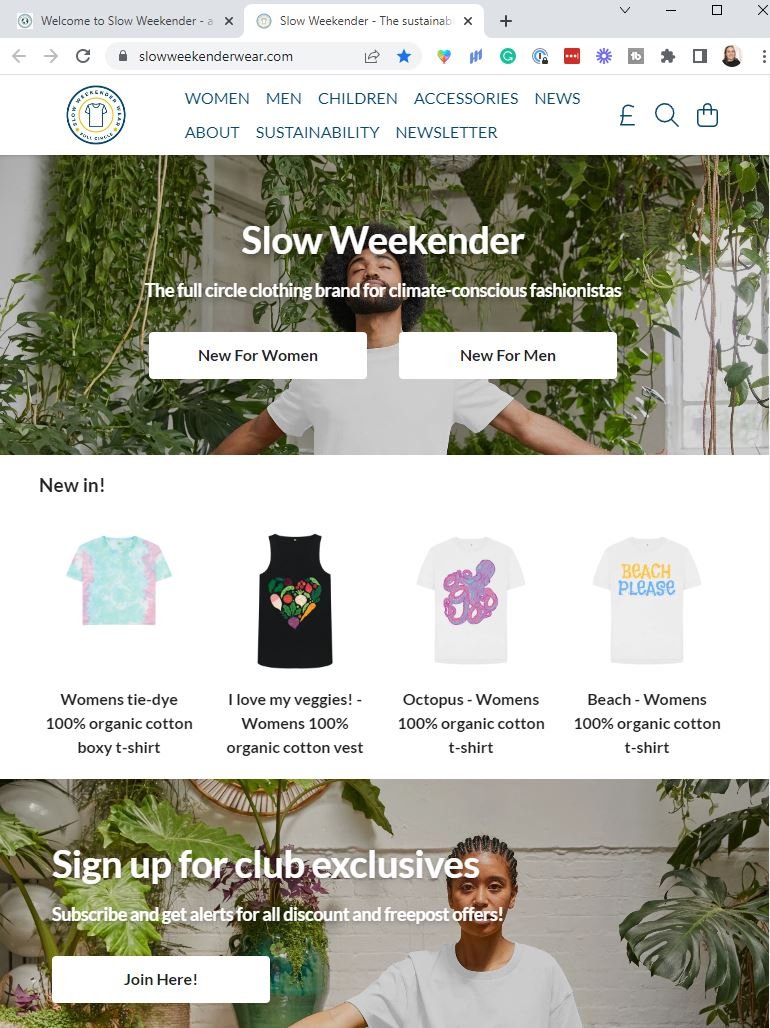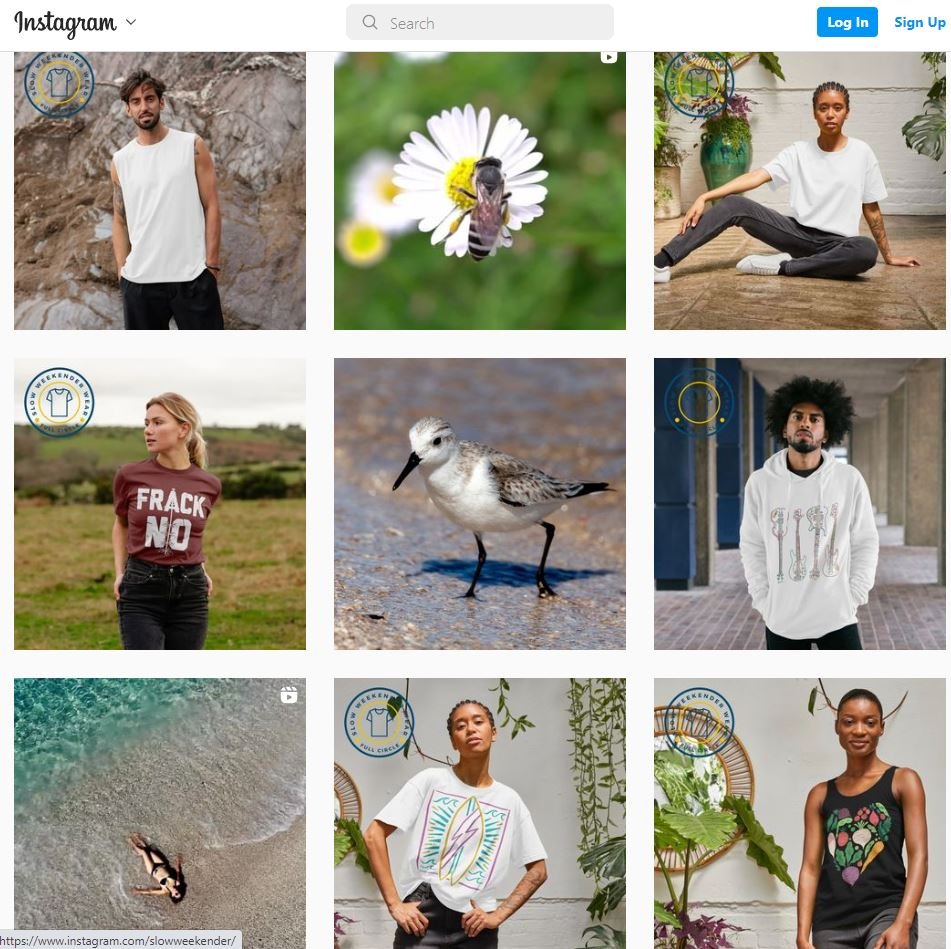As a creator, I want to share my love of content writing across many different genres. A great way to do that is to create examples I can share in my marketing portfolio to show to potential clients. Slow Weekender is one of these projects.
Portfolio study aims
In undertaking this portfolio study I wanted to
Develop my content writing skills in a new area, utilising what I understand in marketing already
Create discussion around sustainability within ourselves, our environment and what we consume.
See what it would be like to work in an online magazine environment
See what starting a business from scratch looks like in 2021/22.
The time allotted for the project was up to 10 hours per month over 9 months.
“I love my veggies” printed vest
Actions: What I did as part of this portfolio study
Creating something from scratch and on this scale requires a process, so I worked my way along a logical path of discovery and realisation.
1. I developed a brand and tone of voice guide from my initial research
By creating a very simplistic brand and tone of voice (TOV) document I was able to establish a basic outline of who the target customer was and what we would be serving them in terms of website, content, socials and products.
Rough outline for a branding and TOV document
2. The website build
Having my brand and TOV guidelines allowed me to move on to the website build.
I designed and created content for both the main website and the initial e-commerce arm. For this, I have used my skills on Squarespace and the full-circle clothing partner Teemill.
The content was designed with TOV in mind and both websites considered SEO and UX (user experience).
Screenshot of Slow Weekender website
Screenshot of Slow Weekender Wear website
3. E-commerce design and product listings
Whilst Slow Weekender Wear (the e-commerce arm of the business) was never designed to be a big income stream, the site design and product listings were crafted to sell products. The aim was to cover costs on time for this living portfolio piece, which it did nicely.
4. Limited social and newsletter drops
To back up any web presence and promote products I created minimal effort social and email campaigns. I wanted to go further but time constraints were very much an issue.
My work in this area included creating tagged landing pages so I could auto-segment mailing list subscribers as they hit subscribe.
Screenshot of Mailchimp landing page subscribe box
Screenshot of Mailchimp landing page below the fold content
Socials were often product-focused, but environmentally or seasonally themed and captioned. I created content for Instagram primarily, but also Facebook and Twitter.
Screenshot of Instagram profile
Screenshot of Instagram grid
5. Content Writing
The biggest aim for me, in this entire project, was to write articles on the concept of slow living, whether that is looking at
sustainability and environmental issues
mental health and wellbeing
suggestions for spending your time at home
travel
These are subject areas that I am very passionate about and haven’t yet had the opportunity to work with clients on. I hope that by creating writing examples (see below) I can do this.
The topic scope was categorised by pillar content, segmenting the website nicely for SEO understanding. The main areas of writing would cover ‘days at home’, ‘days out’, ‘work’ and ‘slow living and sustainability’.
Days at home - covering topics of slow living and mental health by providing ideas on sustainability in the home, or inspiration for self-care activities.
Days out - covering day trips, checklists and ideas for travelling sustainably and healthily.
Work - covering discussions on the idea of work and mental health.
Slow living and sustainability - Looking deeper at topics surrounding a more thoughtful, ethical and environmentally friendly way of living.
Examples include
Screenshot of two magazine articles under the pillar 'slow living and sustainability’
Screenshot of two magazine articles under the pillar 'days out’
Screenshot of two magazine articles under the pillar 'work'
Screenshot of two magazine articles under the pillar 'days at home’
Portfolio study results:
Web results*
Got On-page SEO to 95/100 (first build started at 72)
Monthly page views rose to 716 in months 4-8
Average page consumption per month was between 5-6 pages on each visit (5 is the average according to Klipfolio)
Average session time was between 2-3 minutes (industry average is 40-60 seconds, according to HubSpot)
Bounce rate between 20-30% on average (40+% is an average bounce rate for this industry according to Content Square)
Highest traffic referals came from Google and social media
Top pages after the home page, slow living blog category page, vegan recipes and then sustainable living tips
Highest performing blog post was 3 flavoured vegan butter recipes (aggregated content)
Social results*
Twitter - an average of 9.7% in engagement rate (0.01% was the average in 2021, according to Social Insider)
Instagram - an average of 3.4% in engagement rate (0.78% was the average in 2021, according to the same report)
Facebook - an average of 2% in engagement rate (0.08% was the average in 2021, according to the same report)
* You have to remember the context here was that I had no more than 10 hours per month to work on this project across a 9 month period. Most start-ups would put in a lot more time each week and probably start with a focused launch strategy for layering marketing campaigns at recognised intervals.
You also need to account for a small following in these results. A freshly finished website has a very small following, so the resulting data can look impressive when compared to industry averages where websites potentially receive thousands of visitors each day. The chances are that if the business grew these numbers would level out to a more reflective and comparative position.
Final thoughts: What I’m taking forward
Tapping into my fashion roots and my passion here allowed me to create results, but tackling a project of this scope quickly highlighted the magnitude of the task vs. my time.
Ultimately I bit off more than I could chew!
That’s ok, it taught me a lot.
1. You can create results from scratch
If you start with a plan of attack you can quickly build results from scratch. What you can’t do is build a brand quickly across multiple disciplines of marketing by yourself.
Next time I aim to drill down my focus to one specific project aim.
2. Sometimes the content you thought would lead isn’t what readers want
I think it’s fair to say that I didn’t expect recipes to be a big draw for my blog, but that’s the great thing about data collection - it quickly shows you want readers want from your space. It also showed me what slow living means to my buyer persona.
This could have been a huge change of direction for the blog and the brand, and an easier decision about future projects and products.
3. In the early stages a blog does need a heck of a lot of promotion
Not news to me, but an important reminder nonetheless. Social media is crucial in building out a completely new business online, even if it doesn’t produce massive results by comparison to SEO growth, it is quicker at spreading awareness while search engines watch and rank your site.
4. Create a second portfolio study based on one area of content marketing
I started this project at a time when I was still offering limited email and social media packages to clients. Having realised my passion for longer-form content (namely website, ebook and blog writing) the project wasn’t quite what I needed in my portfolio.
If nothing else this helped me realise how I want to work with clients going forward - no bad thing!
For my next portfolio study, I’ll be creating the focus around long-form pieces.
5. Passion is everything
When you are starting a new business from scratch you must have passion for your niche. I don’t think I would have stuck to this if I didn’t love what I was working on.
The same goes for writing. I won’t write content for an industry I don’t feel some passion or connection to. Again this is not a bad discovery!
6. Set up an automated system early on
I recently discovered Notion for project planning and I have it set up to help me manage marketing activities for my content marketing business. I spent time setting up templates I could use for ideation which helped me create content and publish it more regularly.
I needed this at the start of Slow Weekender.
Systems like this would have saved me time and created more focus when I was able to work on the project.
7. Aggregated content might have been better if site traffic was a primary aim
There’s something to say for aggregated content in magazines or news-style websites. If curation is organised and sympathetically compiled, it could work wonders at building site traffic and domain authority quickly.
Maybe even brand authority too, if you mix in some personal takes.
Of course, this wasn’t the aim of this specific project (I wanted to write all of the content), but you can understand where aggregation or UGC (user-generated content) might work for this type of business.
If you need a copywriter to create compelling copy, someone who understands the customer journey, fill in the project brief form below!

















